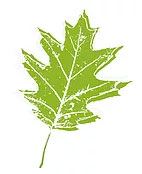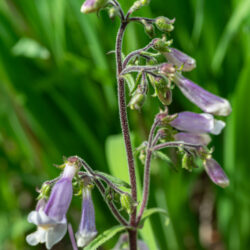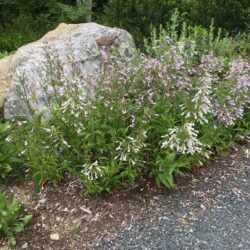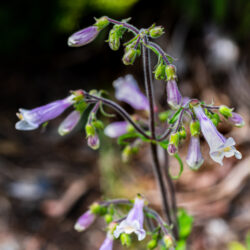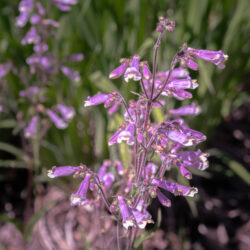Etymology
Hirsutus is Latin for “hairy”. Penstemon means “beardtongue,” which refers to the sterile, hairy stamen protruding from the flower.
Native Habitat
Man-made or disturbed habitats, cliffs, balds, ledges, meadows and fields, ridges, woodlands.
Garden Uses
With its adaptability to medium-wet to dry soils and a range of light conditions, this plant is a versatile option for many gardens. A resilient, deer-resistant perennial, it boasts attractive flowers in late spring to early summer that are of special value to native pollinators. Its compact height makes it ideal for the front of a border. Use in both formal and informal flower beds, shorter wildflower gardens, meadows, patios, and micro-prairies. For a vibrant display, consider planting in groups. Because these plants adapt to a variety of growing conditions, they can naturalize an area, especially if it is dry and rocky. It self-seeds but does not spread aggressively. Space plants about 1 foot apart.
Overview
Penstemon hirsutus is a flowering, deciduous, herbaceous perennial with a dense, erect, and multi-stemmed form. It has a rapid growth rate and is low maintenance. It is marked by its erect, hairy stems, with multiple stems often emerging from the same rhizome. It features open, stalked clusters of lavender to violet, trumpet-shaped flowers with whitish lips. Hirsutus thrives in well-drained, typically dry soil and prefers full sun to partial shade. Its early bloom time and hairy stems distinguish it from other Beardtongues.
Spread
Above ground spread ranges from 1 to 2 feet. Plants can be spaced about 1 foot apart.
Leaves and Stems
The leaves are simple, opposite, stemless and lance-shaped with toothed margins, and turn a beautiful red in the fall. Basal leaves persist throughout the year. Stem (often multiple) is erect, covered in fine, soft hairs, and often reddish in color.
Flowers
In early summer, airy clusters of pale lavender trumpet-shaped slender flowers emerge on the top of erect stems. Hues range from lavender to violet to blue, with whitish lips. The thin inch-long blooms have five petals with a protruding, hairy lower lip that evokes the species’ common name.
Fruit/Seed
Dry, capsule-shaped fruits about 1/4″ in diameter turn brown and hard, lingering throughout winter.
Wildlife Associates
A valuable food source for bees, wasps, butterflies, skippers, moths, and hummingbirds, this plant is particularly beneficial to native bees and bumblebees, according to the Xerces Society. It also serves as a larval host for the Baltimore Checkerspot butterfly. It is deer-resistant.
Propagation
According to the Rhode Island Wild Plant Society: The best method of propagating native penstemons is from seed. The dried capsules yield many seeds in the fall. Although seed packets often recommend a period of cold stratification, good results may be obtained by planting directly in pots or flats. Warm sunshine and moisture should help produce seedlings within four weeks. Plants spend the first summer establishing roots and usually do not bloom until the following year. Note: Penstemons may cross pollinate and produce hybrids if more than one variety is blooming in the garden at the same time.
Garden Location
Library Garden (see garden map)
Sources
North Carolina Extension Gardener Plant Toolbox
Rhode Island Wild Plant Society
Plant Profile by Rachel Emus
